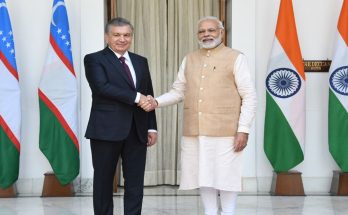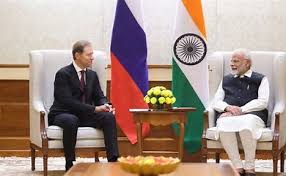Delivering his maiden budget speech on 10th July 2014, the Finance Minister, who also happens to hold the charge of the defence portfolio, talked about the challenging task of reviving growth, particularly in manufacturing and infrastructure, to raise adequate resources for the developmental needs.
In the same breath, he also said that this task would be simple if we accept the principle that we cannot spend beyond our means.
The additional allocation of INR 5,000 crore for defence budget over what had been allocated in the interim budget must be seen in this perspective.
With this additional allocation, the defence budget for the 2014-15 now stands at 2,29,000 crore, an increase of 12.43% over last year’s revised estimates. This is the highest year-on-year increase in defence budget since 2005-06, barring back to back increase of nearly 25% in 2008-09 and 2009-10. That increase was necessitated by the sixth central pay commission.
The defence budget accounts for 1.78% of the GDP and 12.76% of the total central government expenditure. The revenue to capital ration stands at 60:40.
Since the entire increase of INR 5,000 crore is in the capital budget, it goes up to INR 94,588 crore, an increase of 19.93% over last year’s revised estimates. This may be nowhere near 59.80% increase in the capital budget in 2004-05 but, barring that year, it is certainly the highest since 2002-03.
The capital acquisition budget, which is a notional sub-set of the capital budget stands at INR 75,3151, which is the second highest since 2002-03. It accounts for 84% of the total capital budget.
There is no change in the allocation for revenue expenditure which stands at INR 1,34,412 crore. It might be disappointing for some but it is obvious that the need for fiscal prudence and inter-generational equity that the Finance Minister talked about prevented him from increasing the revenue budget.
What do these figures imply?
While increase under practically all the revenue budget heads across all the services and departments, except for pay & allowances, is rather modest, two areas stand out. Pay & allowances alone account for approximately 66% of the revenue budget.
With an increase of just about INR 535 crore under the stores budget, Indian Army still seems to be far away from making up the shortage of ammunition. Allocation for Ex-servicemen Health Scheme (ECHS) has gone down by about 356 crore. It is difficult to imagine how the scheme would be kept running.
The ordnance factories expect to recover INR 10,880 crore from supplies to be made to the armed forces. This is barely INR 838 crore more than last year’s revised estimates. Either the armed forces do not have funds to buy more from them or the ordnance factories themselves are in no position to increase their production.
There are some interesting developments on the capital side. One, a new budget head: Defence Rail Network has been opened with an INR 1,000 crore being allocated for this purpose out of the additional allocation of INR 5,000 crore. This is obviously meant for the railway network in the border areas but considering that the budget for the Border Roads Organization (BRO) forms part of the Demand for Grant of the Ministry of Road Transport and Highways, opening of this budget head in the defence budget is somewhat puzzling.
BRO is administratively controlled by the Border Roads Development Board, which is a part of the Ministry of Defence (MoD) and yet its budget is not a part of the defence budget. Railway network will obviously not be laid by, or probably even managed by, the armed forces. Therefore, development of railway network being a part of the defence budget is inexplicable. However, it is a rather minor issue.
More interestingly, the balance additional allocation of INR 4,000 crore has not gone to the budget heads which are, by convention, considered to be a part of the capital acquisition budget. This amount is shared by the Defence Research & Development Organization (DRDO) (INR 3,323 crore) and the ordnance factories (Rs 677 crore). It is obvious that big plans are afoot to give a fillip to research and development and modernization of the ordnance factories. The details should hopefully emerge in the near future.
Does it mean that the capital acquisition has been ignored? It certainly does not appear to be the case. At INR 75,315 crore2, the capital acquisition budget for the current year is INR 8,947 crore more than the revised estimate for the previous year. Going by the experience of the past ten years, spending this much amount may, in itself, be a challenge. Barring 2004-05, the year-on-year increase in the actual expenditure has never been of that magnitude.
There are speculations whether the present budget is sufficient to meet expenditure on big ticket items that are in the pipeline. It is futile to be speculative. One does not know for certain how much of the capital acquisition budget is earmarked for new schemes. But one has to bear in mind that it is only the advance payment – generally 15% of the contract value – that becomes payable on signing of a new contract. Thus, even if new contracts are signed for say INR 50,000 crore, MoD will require just about INR 7,500 crore for those schemes – not a very tall order even under the prevailing circumstances.
Secondly, at least as of now, no very big contract seems to be nearing the signing stage. Therefore, it would have made no sense to block the money in anticipation of such a contract being signed. There is no doubt that MoF will make additional funds available, if required, to meet the expenditure on any such big new scheme.
There are four other important announcements made by the Finance Minister in his speech.
The first of these concerns raising of the composite cap on FDI in defence to 49%. It may be recalled that under the present regime FDI is allowed up to 26% and beyond that it can be allowed on a case-to-case basis provided it results in access to the state-of-art technologies. This has hardly stimulated the foreign investors with total FDI in defence standing at an embarrassingly low of less than INR 25 crore over the entire period since the defence sector was opened in 2001.
The government has taken a pragmatic step by delinking FDI up to 49% from transfer of the state-of-art technology. It puts to rest a rancorous debate on pros and cons of opening the defence sector to higher FDI. Given the inherent strength of the Indian economy and the comparative advantage of operating out of India, this decision should give a boost to FDI in the defence manufacturing sector. It should also generate greater employment.
Much would also depend on the fine print of the revised scheme. While announcing the increase in the composite FDI cap to 49%, the Finance Minister also said that this will be ‘with full Indian management and control’. One will have to wait for the government notification to fully understand the implication of this stipulation.
The eco-system, however, remains a matter of concern. India cannot expect to rise from its 134th position in the global ease-of-doing business index if something is not done immediately to make it easier for the industry to operate.
With the contentious issue of FDI having been put to rest, the ball is now squarely in the court of the domestic industry. They will have to shoulder the responsibility of developing the state-of-art technologies required by the services.
The second important announcement concerns allocation3 of an additional amount of INR 1,000 crore for implementation of one-rank-one-pension scheme. This year’s allocation is INR 5,500 crore more than last year’s revised estimate, which might be enough to absorb the impact of increase in pension, but any delay in resolving seemingly intractable issues that have cropped up and are delaying implementation of the decision could spoil the feel-good factor.
The third announcement concerns setting up of a Technology Development Fund with a corpus of INR 100 crore. The details are not known but it may be worth recalling that a similar effort made more than five years back ran aground because it was not found feasible to create a ‘fund’ and, more importantly, framing the scheme proved to be a greater challenge.
The new proposal should also not end the same way as the effort to make budgetary provisions for assistance to small and medium enterprises for technology development. A budget head was opened for this purpose several years back but efforts at formulating a scheme to operationalise the idea did not succeed.
The past experience would come in handy while formulating the scheme for the proposed Technology Development Fund.
It might be useful to include this in the charter of the committee that the Finance Minister proposed to set up to give concrete suggestions within three months on financing of the small and medium enterprises.
Lastly, the Finance Minister has met a long standing demand by allocating INR 100 crore for building a War Memorial at the Princess Park near India Gate in New Delhi, which will be supplemented by a War Museum. It would be a befitting tribute to the Indian armed forces.
While presenting the budget, the Finance Minister pointed out that his proposals are first steps and are only directional. It will be comforting if what the budget had in store for defence is also seen in this perspective.
Courtesy: IDSA
Author Profile
- India Writes Network (www.indiawrites.org) is an emerging think tank and a media-publishing company focused on international affairs & the India Story. Centre for Global India Insights is the research arm of India Writes Network. To subscribe to India and the World, write to editor@indiawrites.org. A venture of TGII Media Private Limited, a leading media, publishing and consultancy company, IWN has carved a niche for balanced and exhaustive reporting and analysis of international affairs. Eminent personalities, politicians, diplomats, authors, strategy gurus and news-makers have contributed to India Writes Network, as also “India and the World,” a magazine focused on global affairs.
Latest entries
 India and the WorldNovember 26, 2025G20@20: Africa’s Moment – The Once and Future World Order
India and the WorldNovember 26, 2025G20@20: Africa’s Moment – The Once and Future World Order DiplomacyOctober 4, 2025UNGA Resolution 2758 Must Not Be Distorted, One-China Principle Brooks No Challenge
DiplomacyOctober 4, 2025UNGA Resolution 2758 Must Not Be Distorted, One-China Principle Brooks No Challenge India and the WorldJuly 26, 2025MPs, diplomats laud Operation Sindoor, call for national unity to combat Pakistan-sponsored terror
India and the WorldJuly 26, 2025MPs, diplomats laud Operation Sindoor, call for national unity to combat Pakistan-sponsored terror India and the WorldJuly 25, 2025When Fire Ends, Diplomacy Begins
India and the WorldJuly 25, 2025When Fire Ends, Diplomacy Begins







